University Report: Corporate Governance and Risk Management Analysis
VerifiedAdded on 2023/06/05
|7
|1643
|78
Report
AI Summary
This report delves into the critical concepts of corporate governance and risk management, highlighting their significance in the business world. It emphasizes the importance of ethical operations, enhancing shareholder value, and addressing stakeholder interests through effective corporate governance structures and procedures. The report explores risk management as the process of identifying, evaluating, and prioritizing risks to mitigate their impact on business objectives. It examines the relationship between corporate governance and risk management, particularly in light of the 2008 financial crisis, emphasizing the need for effective governance to control risks ethically. The report covers key aspects of corporate governance, including the roles of governing bodies, business ethics, corporate social responsibility, and common issues such as conflicts of interest and transparency. It also discusses risk management failures, using examples like the Lehman Brothers bankruptcy, and stresses the importance of an organization-wide approach to risk management. The report concludes by advocating for integrating risk management at all levels of the organization, promoting sustainable business practices, and implementing ethical measures of corporate governance to avoid long-term failures.
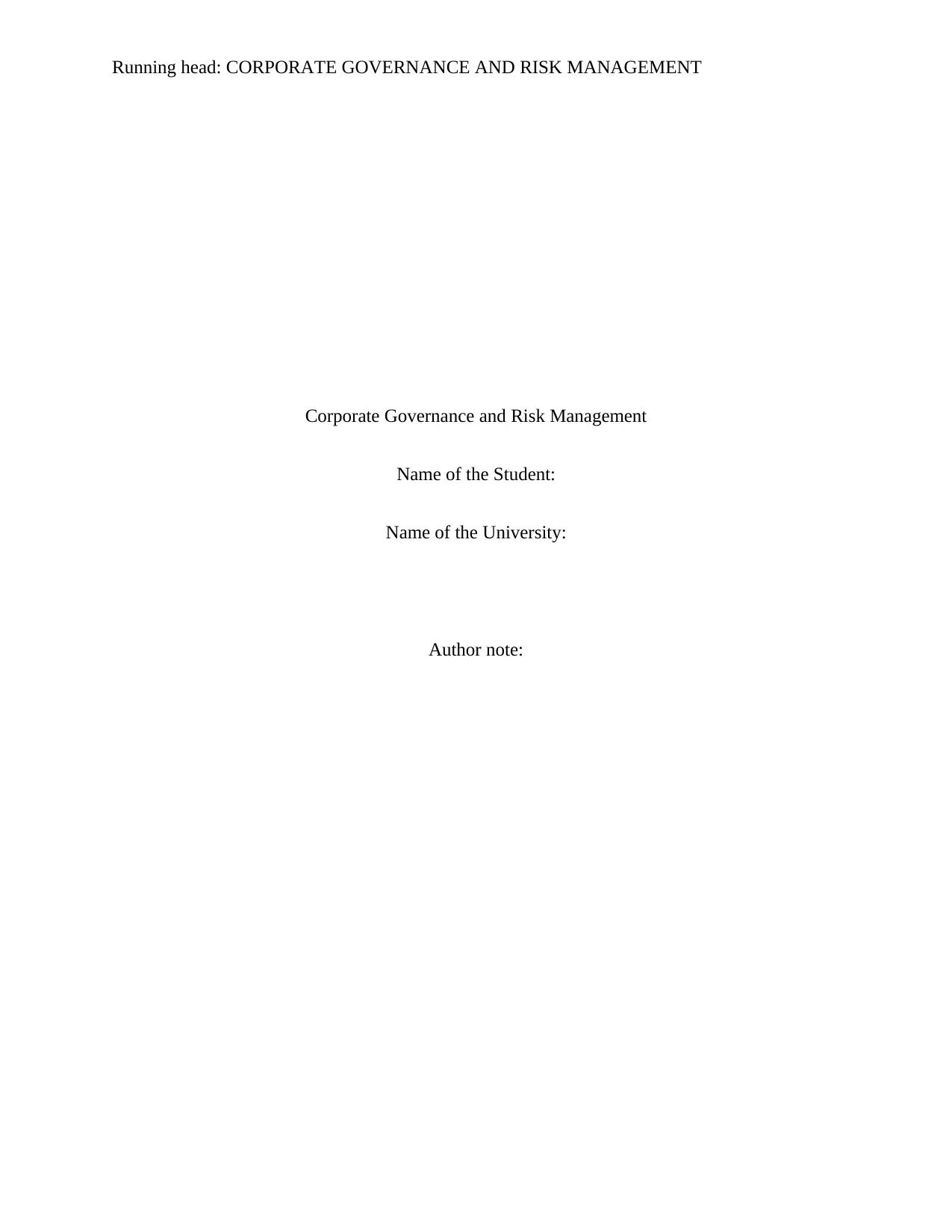
Running head: CORPORATE GOVERNANCE AND RISK MANAGEMENT
Corporate Governance and Risk Management
Name of the Student:
Name of the University:
Author note:
Corporate Governance and Risk Management
Name of the Student:
Name of the University:
Author note:
Paraphrase This Document
Need a fresh take? Get an instant paraphrase of this document with our AI Paraphraser
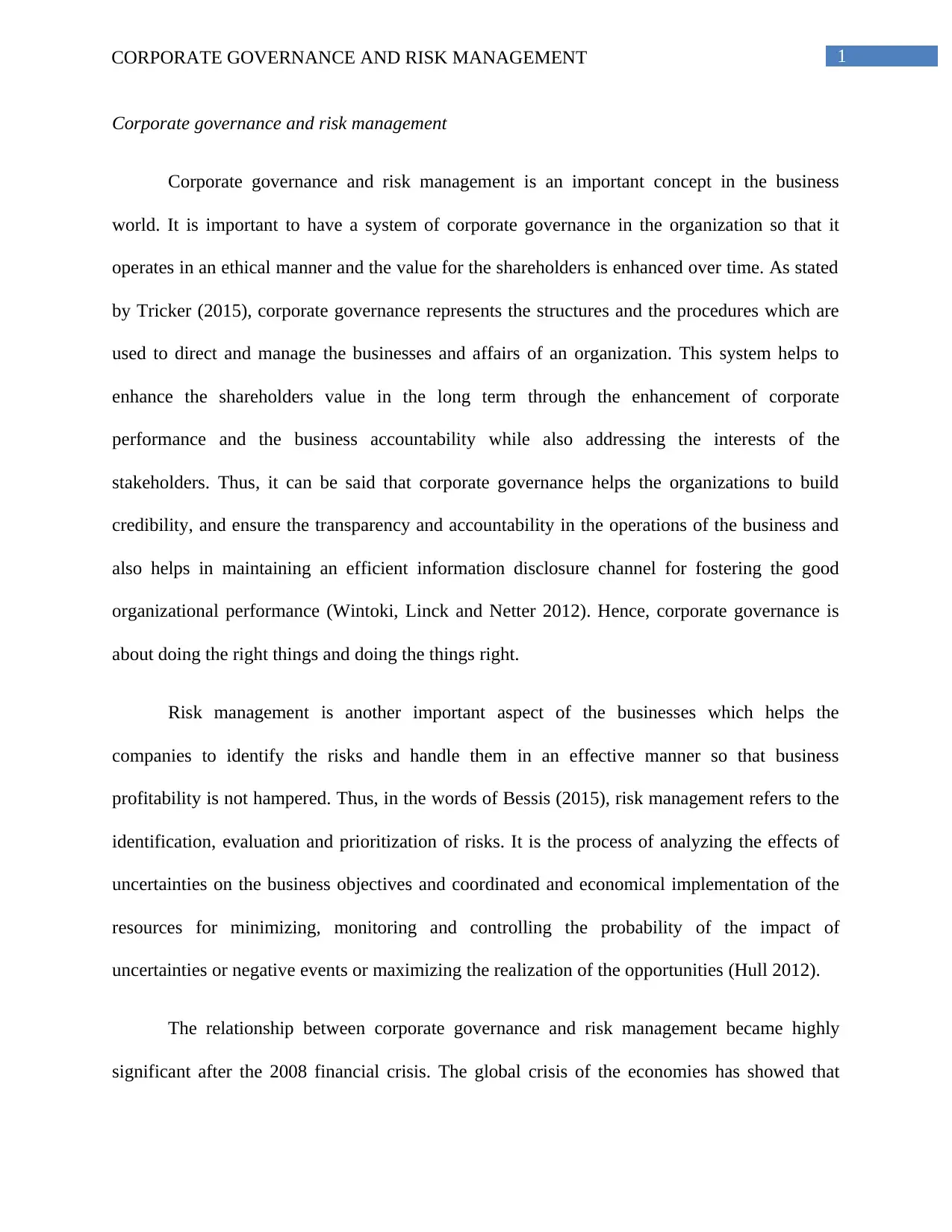
1CORPORATE GOVERNANCE AND RISK MANAGEMENT
Corporate governance and risk management
Corporate governance and risk management is an important concept in the business
world. It is important to have a system of corporate governance in the organization so that it
operates in an ethical manner and the value for the shareholders is enhanced over time. As stated
by Tricker (2015), corporate governance represents the structures and the procedures which are
used to direct and manage the businesses and affairs of an organization. This system helps to
enhance the shareholders value in the long term through the enhancement of corporate
performance and the business accountability while also addressing the interests of the
stakeholders. Thus, it can be said that corporate governance helps the organizations to build
credibility, and ensure the transparency and accountability in the operations of the business and
also helps in maintaining an efficient information disclosure channel for fostering the good
organizational performance (Wintoki, Linck and Netter 2012). Hence, corporate governance is
about doing the right things and doing the things right.
Risk management is another important aspect of the businesses which helps the
companies to identify the risks and handle them in an effective manner so that business
profitability is not hampered. Thus, in the words of Bessis (2015), risk management refers to the
identification, evaluation and prioritization of risks. It is the process of analyzing the effects of
uncertainties on the business objectives and coordinated and economical implementation of the
resources for minimizing, monitoring and controlling the probability of the impact of
uncertainties or negative events or maximizing the realization of the opportunities (Hull 2012).
The relationship between corporate governance and risk management became highly
significant after the 2008 financial crisis. The global crisis of the economies has showed that
Corporate governance and risk management
Corporate governance and risk management is an important concept in the business
world. It is important to have a system of corporate governance in the organization so that it
operates in an ethical manner and the value for the shareholders is enhanced over time. As stated
by Tricker (2015), corporate governance represents the structures and the procedures which are
used to direct and manage the businesses and affairs of an organization. This system helps to
enhance the shareholders value in the long term through the enhancement of corporate
performance and the business accountability while also addressing the interests of the
stakeholders. Thus, it can be said that corporate governance helps the organizations to build
credibility, and ensure the transparency and accountability in the operations of the business and
also helps in maintaining an efficient information disclosure channel for fostering the good
organizational performance (Wintoki, Linck and Netter 2012). Hence, corporate governance is
about doing the right things and doing the things right.
Risk management is another important aspect of the businesses which helps the
companies to identify the risks and handle them in an effective manner so that business
profitability is not hampered. Thus, in the words of Bessis (2015), risk management refers to the
identification, evaluation and prioritization of risks. It is the process of analyzing the effects of
uncertainties on the business objectives and coordinated and economical implementation of the
resources for minimizing, monitoring and controlling the probability of the impact of
uncertainties or negative events or maximizing the realization of the opportunities (Hull 2012).
The relationship between corporate governance and risk management became highly
significant after the 2008 financial crisis. The global crisis of the economies has showed that
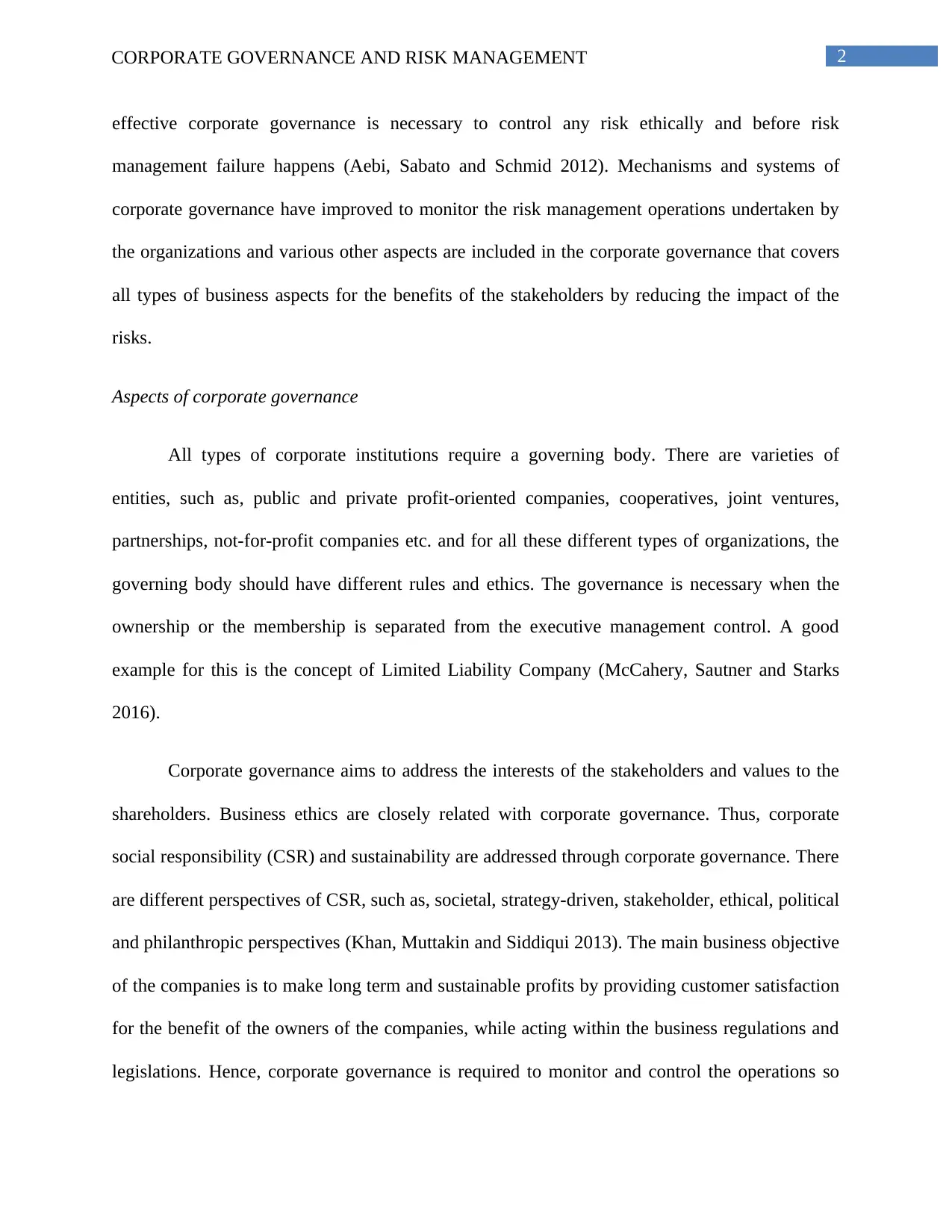
2CORPORATE GOVERNANCE AND RISK MANAGEMENT
effective corporate governance is necessary to control any risk ethically and before risk
management failure happens (Aebi, Sabato and Schmid 2012). Mechanisms and systems of
corporate governance have improved to monitor the risk management operations undertaken by
the organizations and various other aspects are included in the corporate governance that covers
all types of business aspects for the benefits of the stakeholders by reducing the impact of the
risks.
Aspects of corporate governance
All types of corporate institutions require a governing body. There are varieties of
entities, such as, public and private profit-oriented companies, cooperatives, joint ventures,
partnerships, not-for-profit companies etc. and for all these different types of organizations, the
governing body should have different rules and ethics. The governance is necessary when the
ownership or the membership is separated from the executive management control. A good
example for this is the concept of Limited Liability Company (McCahery, Sautner and Starks
2016).
Corporate governance aims to address the interests of the stakeholders and values to the
shareholders. Business ethics are closely related with corporate governance. Thus, corporate
social responsibility (CSR) and sustainability are addressed through corporate governance. There
are different perspectives of CSR, such as, societal, strategy-driven, stakeholder, ethical, political
and philanthropic perspectives (Khan, Muttakin and Siddiqui 2013). The main business objective
of the companies is to make long term and sustainable profits by providing customer satisfaction
for the benefit of the owners of the companies, while acting within the business regulations and
legislations. Hence, corporate governance is required to monitor and control the operations so
effective corporate governance is necessary to control any risk ethically and before risk
management failure happens (Aebi, Sabato and Schmid 2012). Mechanisms and systems of
corporate governance have improved to monitor the risk management operations undertaken by
the organizations and various other aspects are included in the corporate governance that covers
all types of business aspects for the benefits of the stakeholders by reducing the impact of the
risks.
Aspects of corporate governance
All types of corporate institutions require a governing body. There are varieties of
entities, such as, public and private profit-oriented companies, cooperatives, joint ventures,
partnerships, not-for-profit companies etc. and for all these different types of organizations, the
governing body should have different rules and ethics. The governance is necessary when the
ownership or the membership is separated from the executive management control. A good
example for this is the concept of Limited Liability Company (McCahery, Sautner and Starks
2016).
Corporate governance aims to address the interests of the stakeholders and values to the
shareholders. Business ethics are closely related with corporate governance. Thus, corporate
social responsibility (CSR) and sustainability are addressed through corporate governance. There
are different perspectives of CSR, such as, societal, strategy-driven, stakeholder, ethical, political
and philanthropic perspectives (Khan, Muttakin and Siddiqui 2013). The main business objective
of the companies is to make long term and sustainable profits by providing customer satisfaction
for the benefit of the owners of the companies, while acting within the business regulations and
legislations. Hence, corporate governance is required to monitor and control the operations so
⊘ This is a preview!⊘
Do you want full access?
Subscribe today to unlock all pages.

Trusted by 1+ million students worldwide
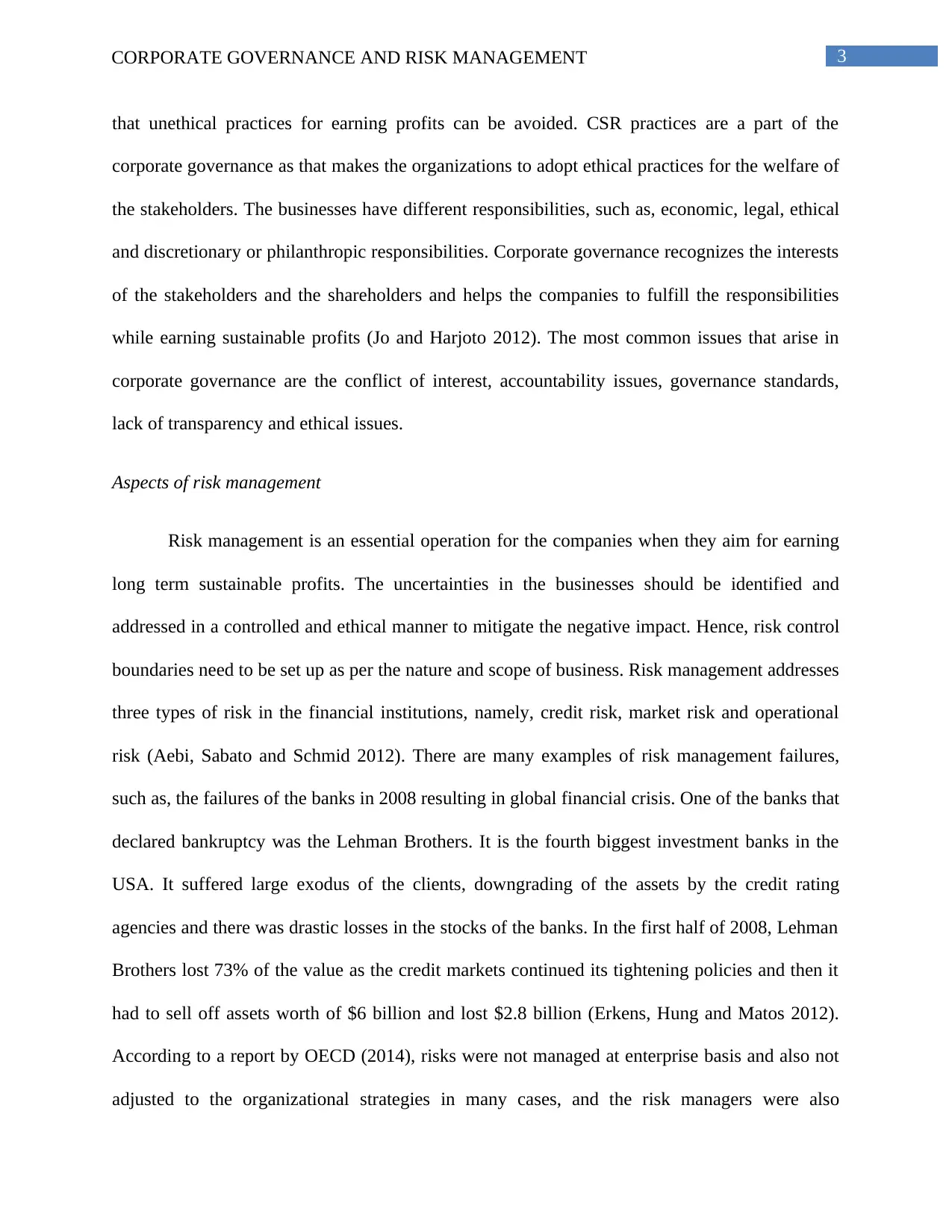
3CORPORATE GOVERNANCE AND RISK MANAGEMENT
that unethical practices for earning profits can be avoided. CSR practices are a part of the
corporate governance as that makes the organizations to adopt ethical practices for the welfare of
the stakeholders. The businesses have different responsibilities, such as, economic, legal, ethical
and discretionary or philanthropic responsibilities. Corporate governance recognizes the interests
of the stakeholders and the shareholders and helps the companies to fulfill the responsibilities
while earning sustainable profits (Jo and Harjoto 2012). The most common issues that arise in
corporate governance are the conflict of interest, accountability issues, governance standards,
lack of transparency and ethical issues.
Aspects of risk management
Risk management is an essential operation for the companies when they aim for earning
long term sustainable profits. The uncertainties in the businesses should be identified and
addressed in a controlled and ethical manner to mitigate the negative impact. Hence, risk control
boundaries need to be set up as per the nature and scope of business. Risk management addresses
three types of risk in the financial institutions, namely, credit risk, market risk and operational
risk (Aebi, Sabato and Schmid 2012). There are many examples of risk management failures,
such as, the failures of the banks in 2008 resulting in global financial crisis. One of the banks that
declared bankruptcy was the Lehman Brothers. It is the fourth biggest investment banks in the
USA. It suffered large exodus of the clients, downgrading of the assets by the credit rating
agencies and there was drastic losses in the stocks of the banks. In the first half of 2008, Lehman
Brothers lost 73% of the value as the credit markets continued its tightening policies and then it
had to sell off assets worth of $6 billion and lost $2.8 billion (Erkens, Hung and Matos 2012).
According to a report by OECD (2014), risks were not managed at enterprise basis and also not
adjusted to the organizational strategies in many cases, and the risk managers were also
that unethical practices for earning profits can be avoided. CSR practices are a part of the
corporate governance as that makes the organizations to adopt ethical practices for the welfare of
the stakeholders. The businesses have different responsibilities, such as, economic, legal, ethical
and discretionary or philanthropic responsibilities. Corporate governance recognizes the interests
of the stakeholders and the shareholders and helps the companies to fulfill the responsibilities
while earning sustainable profits (Jo and Harjoto 2012). The most common issues that arise in
corporate governance are the conflict of interest, accountability issues, governance standards,
lack of transparency and ethical issues.
Aspects of risk management
Risk management is an essential operation for the companies when they aim for earning
long term sustainable profits. The uncertainties in the businesses should be identified and
addressed in a controlled and ethical manner to mitigate the negative impact. Hence, risk control
boundaries need to be set up as per the nature and scope of business. Risk management addresses
three types of risk in the financial institutions, namely, credit risk, market risk and operational
risk (Aebi, Sabato and Schmid 2012). There are many examples of risk management failures,
such as, the failures of the banks in 2008 resulting in global financial crisis. One of the banks that
declared bankruptcy was the Lehman Brothers. It is the fourth biggest investment banks in the
USA. It suffered large exodus of the clients, downgrading of the assets by the credit rating
agencies and there was drastic losses in the stocks of the banks. In the first half of 2008, Lehman
Brothers lost 73% of the value as the credit markets continued its tightening policies and then it
had to sell off assets worth of $6 billion and lost $2.8 billion (Erkens, Hung and Matos 2012).
According to a report by OECD (2014), risks were not managed at enterprise basis and also not
adjusted to the organizational strategies in many cases, and the risk managers were also
Paraphrase This Document
Need a fresh take? Get an instant paraphrase of this document with our AI Paraphraser
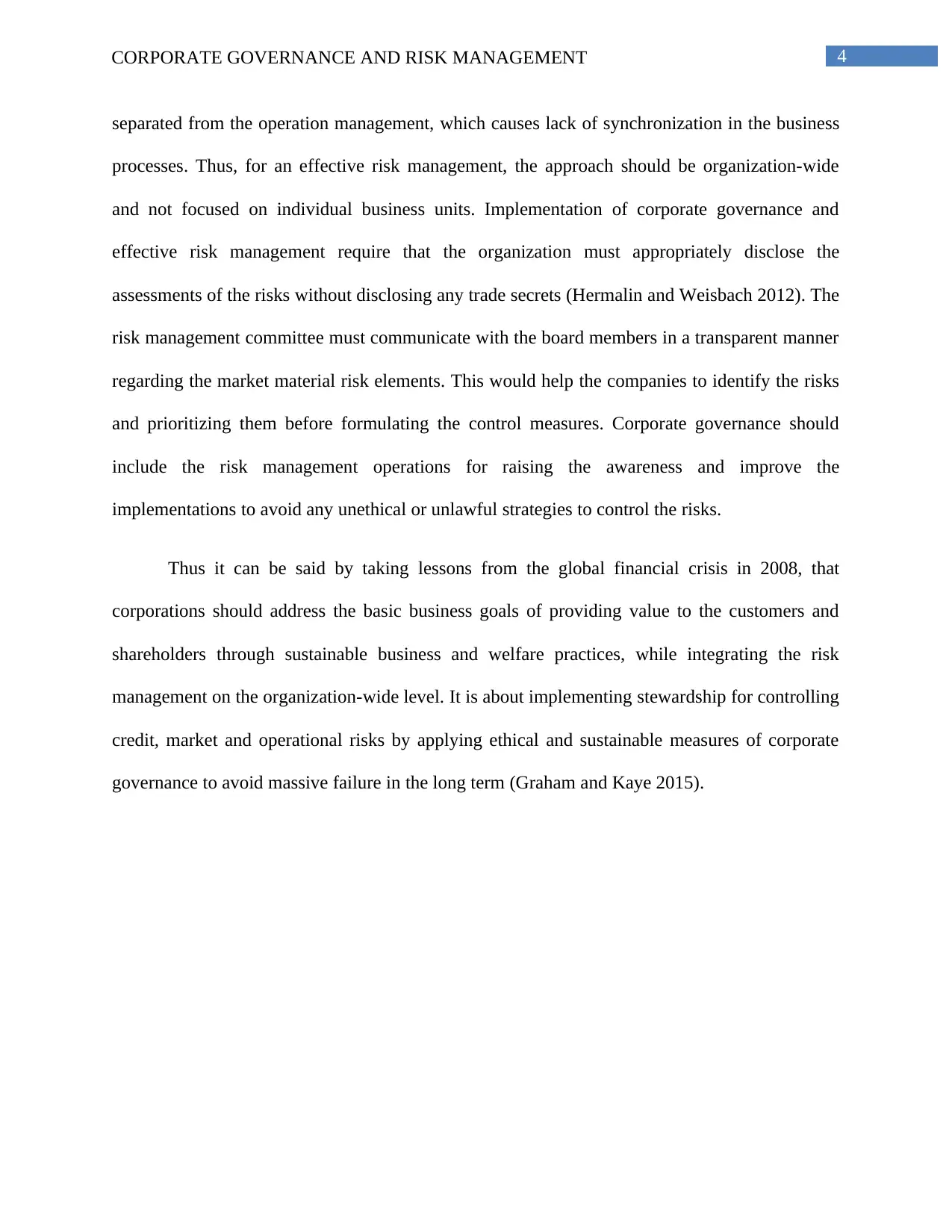
4CORPORATE GOVERNANCE AND RISK MANAGEMENT
separated from the operation management, which causes lack of synchronization in the business
processes. Thus, for an effective risk management, the approach should be organization-wide
and not focused on individual business units. Implementation of corporate governance and
effective risk management require that the organization must appropriately disclose the
assessments of the risks without disclosing any trade secrets (Hermalin and Weisbach 2012). The
risk management committee must communicate with the board members in a transparent manner
regarding the market material risk elements. This would help the companies to identify the risks
and prioritizing them before formulating the control measures. Corporate governance should
include the risk management operations for raising the awareness and improve the
implementations to avoid any unethical or unlawful strategies to control the risks.
Thus it can be said by taking lessons from the global financial crisis in 2008, that
corporations should address the basic business goals of providing value to the customers and
shareholders through sustainable business and welfare practices, while integrating the risk
management on the organization-wide level. It is about implementing stewardship for controlling
credit, market and operational risks by applying ethical and sustainable measures of corporate
governance to avoid massive failure in the long term (Graham and Kaye 2015).
separated from the operation management, which causes lack of synchronization in the business
processes. Thus, for an effective risk management, the approach should be organization-wide
and not focused on individual business units. Implementation of corporate governance and
effective risk management require that the organization must appropriately disclose the
assessments of the risks without disclosing any trade secrets (Hermalin and Weisbach 2012). The
risk management committee must communicate with the board members in a transparent manner
regarding the market material risk elements. This would help the companies to identify the risks
and prioritizing them before formulating the control measures. Corporate governance should
include the risk management operations for raising the awareness and improve the
implementations to avoid any unethical or unlawful strategies to control the risks.
Thus it can be said by taking lessons from the global financial crisis in 2008, that
corporations should address the basic business goals of providing value to the customers and
shareholders through sustainable business and welfare practices, while integrating the risk
management on the organization-wide level. It is about implementing stewardship for controlling
credit, market and operational risks by applying ethical and sustainable measures of corporate
governance to avoid massive failure in the long term (Graham and Kaye 2015).
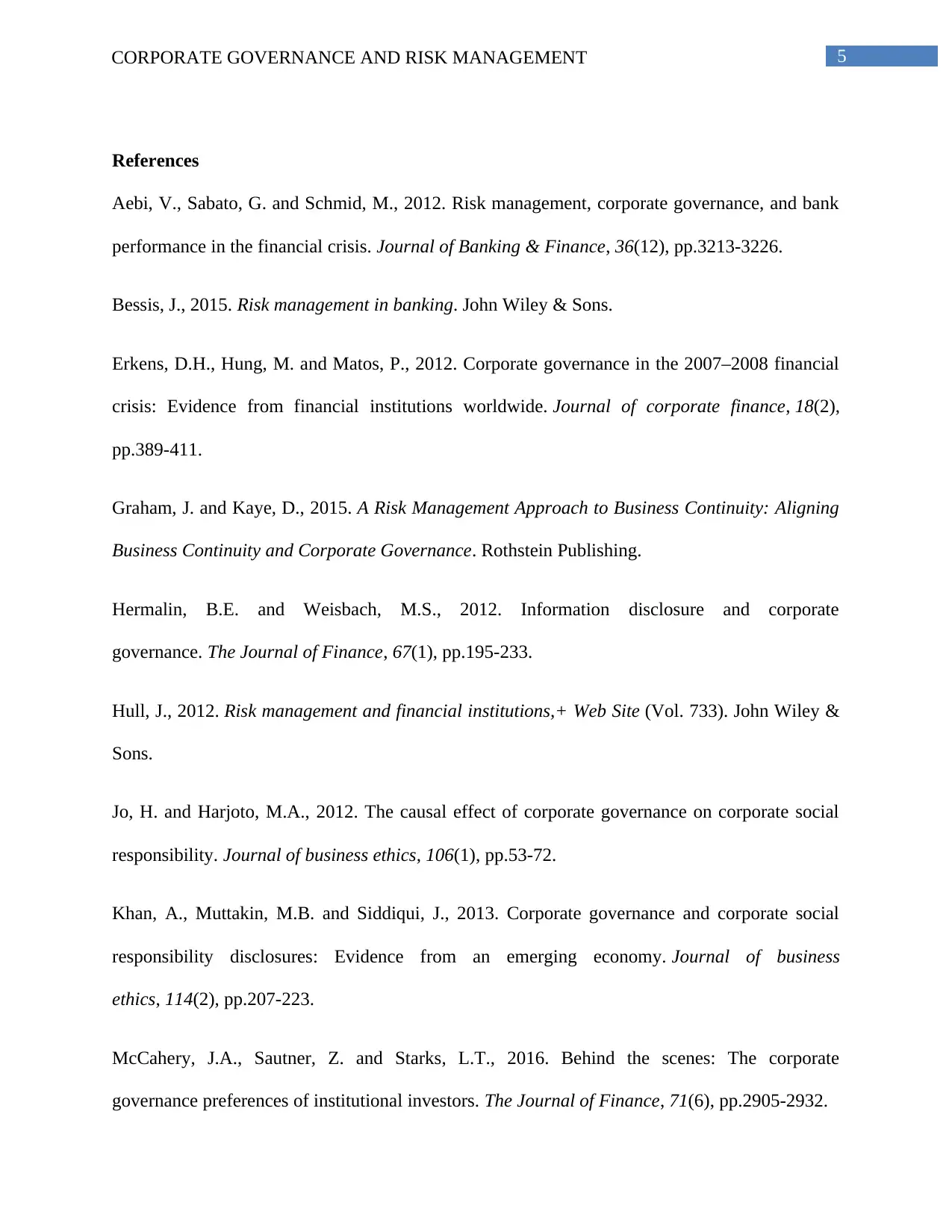
5CORPORATE GOVERNANCE AND RISK MANAGEMENT
References
Aebi, V., Sabato, G. and Schmid, M., 2012. Risk management, corporate governance, and bank
performance in the financial crisis. Journal of Banking & Finance, 36(12), pp.3213-3226.
Bessis, J., 2015. Risk management in banking. John Wiley & Sons.
Erkens, D.H., Hung, M. and Matos, P., 2012. Corporate governance in the 2007–2008 financial
crisis: Evidence from financial institutions worldwide. Journal of corporate finance, 18(2),
pp.389-411.
Graham, J. and Kaye, D., 2015. A Risk Management Approach to Business Continuity: Aligning
Business Continuity and Corporate Governance. Rothstein Publishing.
Hermalin, B.E. and Weisbach, M.S., 2012. Information disclosure and corporate
governance. The Journal of Finance, 67(1), pp.195-233.
Hull, J., 2012. Risk management and financial institutions,+ Web Site (Vol. 733). John Wiley &
Sons.
Jo, H. and Harjoto, M.A., 2012. The causal effect of corporate governance on corporate social
responsibility. Journal of business ethics, 106(1), pp.53-72.
Khan, A., Muttakin, M.B. and Siddiqui, J., 2013. Corporate governance and corporate social
responsibility disclosures: Evidence from an emerging economy. Journal of business
ethics, 114(2), pp.207-223.
McCahery, J.A., Sautner, Z. and Starks, L.T., 2016. Behind the scenes: The corporate
governance preferences of institutional investors. The Journal of Finance, 71(6), pp.2905-2932.
References
Aebi, V., Sabato, G. and Schmid, M., 2012. Risk management, corporate governance, and bank
performance in the financial crisis. Journal of Banking & Finance, 36(12), pp.3213-3226.
Bessis, J., 2015. Risk management in banking. John Wiley & Sons.
Erkens, D.H., Hung, M. and Matos, P., 2012. Corporate governance in the 2007–2008 financial
crisis: Evidence from financial institutions worldwide. Journal of corporate finance, 18(2),
pp.389-411.
Graham, J. and Kaye, D., 2015. A Risk Management Approach to Business Continuity: Aligning
Business Continuity and Corporate Governance. Rothstein Publishing.
Hermalin, B.E. and Weisbach, M.S., 2012. Information disclosure and corporate
governance. The Journal of Finance, 67(1), pp.195-233.
Hull, J., 2012. Risk management and financial institutions,+ Web Site (Vol. 733). John Wiley &
Sons.
Jo, H. and Harjoto, M.A., 2012. The causal effect of corporate governance on corporate social
responsibility. Journal of business ethics, 106(1), pp.53-72.
Khan, A., Muttakin, M.B. and Siddiqui, J., 2013. Corporate governance and corporate social
responsibility disclosures: Evidence from an emerging economy. Journal of business
ethics, 114(2), pp.207-223.
McCahery, J.A., Sautner, Z. and Starks, L.T., 2016. Behind the scenes: The corporate
governance preferences of institutional investors. The Journal of Finance, 71(6), pp.2905-2932.
⊘ This is a preview!⊘
Do you want full access?
Subscribe today to unlock all pages.

Trusted by 1+ million students worldwide
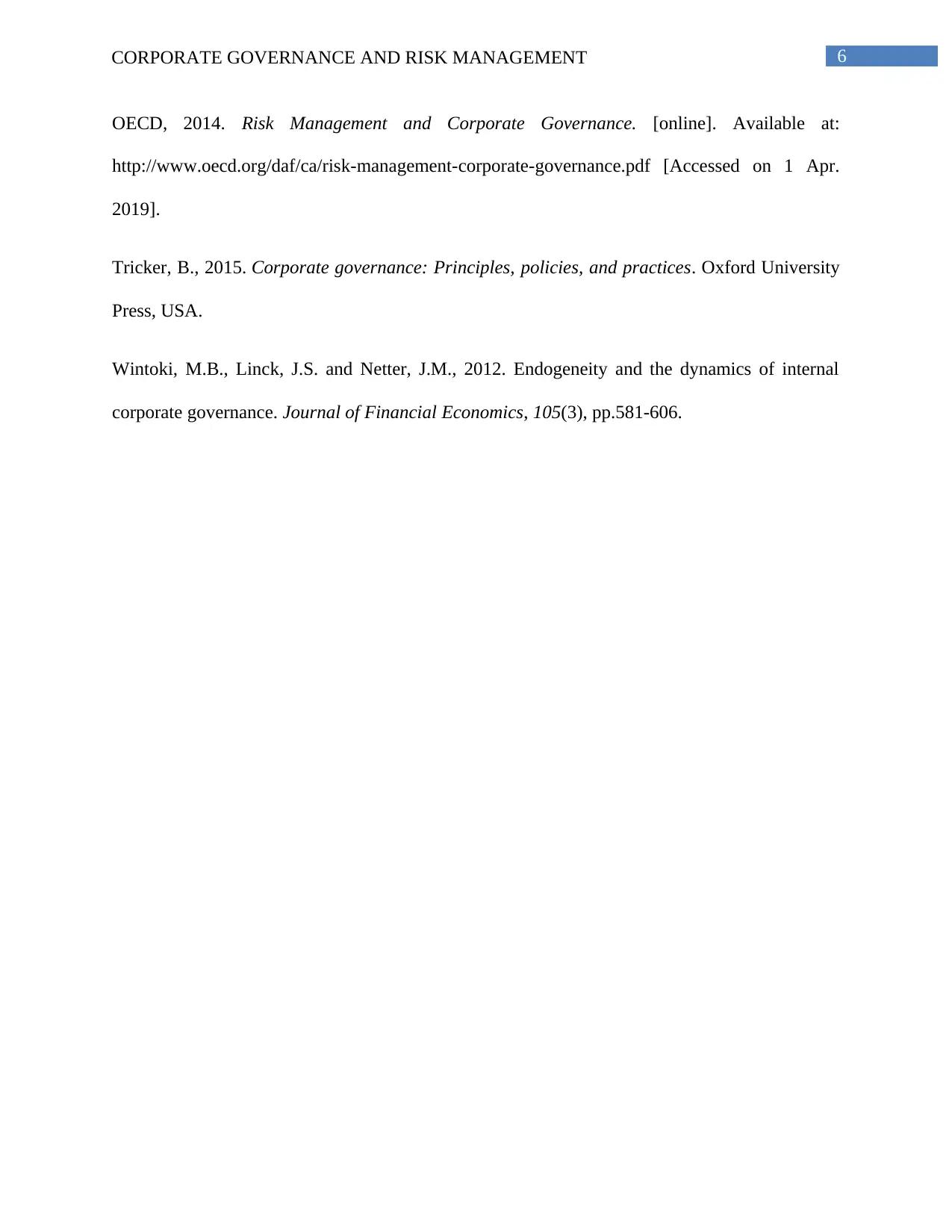
6CORPORATE GOVERNANCE AND RISK MANAGEMENT
OECD, 2014. Risk Management and Corporate Governance. [online]. Available at:
http://www.oecd.org/daf/ca/risk-management-corporate-governance.pdf [Accessed on 1 Apr.
2019].
Tricker, B., 2015. Corporate governance: Principles, policies, and practices. Oxford University
Press, USA.
Wintoki, M.B., Linck, J.S. and Netter, J.M., 2012. Endogeneity and the dynamics of internal
corporate governance. Journal of Financial Economics, 105(3), pp.581-606.
OECD, 2014. Risk Management and Corporate Governance. [online]. Available at:
http://www.oecd.org/daf/ca/risk-management-corporate-governance.pdf [Accessed on 1 Apr.
2019].
Tricker, B., 2015. Corporate governance: Principles, policies, and practices. Oxford University
Press, USA.
Wintoki, M.B., Linck, J.S. and Netter, J.M., 2012. Endogeneity and the dynamics of internal
corporate governance. Journal of Financial Economics, 105(3), pp.581-606.
1 out of 7
Related Documents
Your All-in-One AI-Powered Toolkit for Academic Success.
+13062052269
info@desklib.com
Available 24*7 on WhatsApp / Email
![[object Object]](/_next/static/media/star-bottom.7253800d.svg)
Unlock your academic potential
Copyright © 2020–2025 A2Z Services. All Rights Reserved. Developed and managed by ZUCOL.




